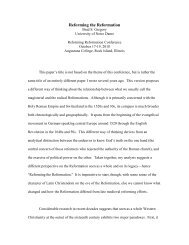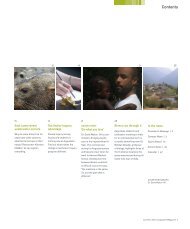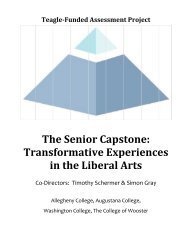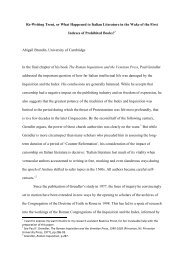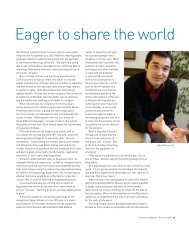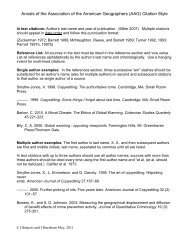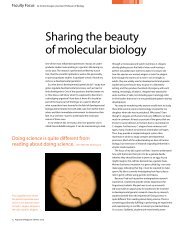Similar
Similar
Similar
Create successful ePaper yourself
Turn your PDF publications into a flip-book with our unique Google optimized e-Paper software.
Why antibiotics<br />
aren’t always<br />
the right<br />
solution for ear<br />
infections<br />
By Dr. Craig Bowron ’87<br />
The Earitable Child<br />
Nestled behind the eardrum is a small space called “the<br />
middle ear,” known to parents of small children as a Den<br />
of Iniquity, the infamous birthplace of “Oh no, another ear<br />
infection.”<br />
Across this cramped space arcs a linkage of three tiny<br />
bones—the Nina, the Pinta, and the Santa Maria. These<br />
connect the eardrum to the cochlea, the snail-like portion<br />
of the inner ear that converts the vibrations of the eardrum<br />
into electrical impulses that the brain recognizes as sound.<br />
The middle-ear space is connected to the back of the<br />
throat via the eustachian tube, which allows us to “add” or<br />
“subtract” air from the middle ear, depending on pressure<br />
changes. If you’ve never had ear pain while riding on an<br />
airplane, you can thank your functioning eustachian tubes.<br />
The trouble typically starts with a cold—a viral infection<br />
that plugs up the nose and, particularly in kids, the<br />
eustachian tubes. With their tiny tubes blocked, the middle<br />
ear becomes an enclosed, undrained space where fluid can<br />
collect. Under low pressure, the only clue to its presence<br />
may be loss of hearing. A parent may experience this as<br />
having to say, “You can’t go to school barefoot—would you<br />
get your shoes on?!” six or seven times, rather than the<br />
usual three or four.<br />
If the fluid is under pressure, the child may experience<br />
pain, especially if it is infected with either bacteria or the<br />
ugly cold virus that started the whole episode. Fever and a<br />
general crankiness help transform the little cherub into a<br />
sleep-deprived, unsoothable potentate.<br />
The medical term for infected fluid in the middle ear is<br />
“acute otitis media,” or AOM. It’s one of the top diagnoses<br />
in the United States for children, responsible for billions of<br />
healthcare dollars and 15 million antibiotic prescriptions<br />
each year.<br />
We can always print more money, and we do. But overusing<br />
antibiotics can weaken their effectiveness, and<br />
replacements are hard to find. Rather than reserving<br />
antibiotics for just severe infections, we’ve been handing<br />
them out for low-grade infections, or for “this might be an<br />
infection,” or for “you’re not infected now, but certainly you<br />
could become infected, if not now, then at some point in<br />
your life.” They’ve become candy with a co-pay.<br />
Now the chicken is coming home to roost, traipsing in<br />
bacteria that are resistant to many first-line antibiotics.<br />
Bacteria may be mindless, but they’re not dumb: given<br />
time, they will figure out how to counter the effects of an<br />
antibiotic. And We, The People, have developed a mentality<br />
that if we have a bacterial infection and don’t get antibiotics,<br />
we will die. Or miss a day of school or work, or worst of all,<br />
a social function.<br />
Deciding whether to treat an “earitable” child with antibiotics<br />
begins with determining whether he or she truly<br />
does have AOM. Several studies have shown that physicians<br />
are unsure of these diagnoses as much as 40 percent of the<br />
time. So despite all the practice we get with this malady, we<br />
could use some more.<br />
Some parents believe they have an extrasensory ability<br />
to detect middle-ear infections in their children, but clinical<br />
symptoms are actually a poor predictor of AOM (though<br />
they’re an excellent predictor of kids being sick). Ear pain<br />
(sometimes manifested as tugging), irritability, and fever are<br />
prominent symptoms in children with middle-ear infections,<br />
but they’re also common in those with bad colds.<br />
Because clinical symptoms can’t differentiate a cold from<br />
AOM, an ear exam is crucial. This is not as easy as it seems,<br />
particularly with infants and toddlers. At the close of the<br />
cartoon classic “The Incredibles,” baby Jack-Jack reveals<br />
two of his special powers: turning first into a gigantic ball<br />
of flame, and then into a hideous version of the Tazmanian<br />
Devil. Youngsters who aren’t feeling well share Jack-Jack’s<br />
transformative powers, which makes examining their ears<br />
an acquired skill. And even if the child’s head is not spinning<br />
like an Indy driver who got loose going into a corner, all too<br />
often there will be earwax obstructing one’s view. Removing<br />
it does nothing to soothe little Jack-Jack.<br />
Assuming one can eventually get a view of the eardrum,<br />
we’re looking for two things: fluid and inflammation. Sometimes<br />
the fluid is easy to spot: the eardrum is bulging outwards,<br />
rather than in its usual flat or slightly concave<br />
position, and the fluid gives the eardrum a yellow or orange<br />
hue. Small amounts of fluid can be more difficult to detect;<br />
then the physician may push a little air into the ear to see if<br />
the eardrum moves normally. If there is pressure in the<br />
middle ear, it will not move well.<br />
Step two is looking for evidence of inflammation, like<br />
the swollen redness one’s nose exhibits during the acute<br />
phase of a cold. White fluid—i.e., pus—behind the eardrum<br />
indicates that a lot of white blood cells have been called<br />
into the area and strongly indicates infection, whether viral<br />
or bacterial. A red eardrum can indicate inflammation,<br />
although it also can look red if the child has been screaming<br />
his or her guts out.<br />
Step three is to decide whether antibiotics are warranted.<br />
According to a position paper from the American Academy<br />
of Pediatrics (AAP) and the American Academy of Family<br />
Physicians (AAFP), children under 2 with a definite diagnosis<br />
of AOM should receive antibiotics. Older kids can be<br />
treated with just pain relievers as long they do not appear<br />
markedly ill (usually, with a high fever or severe ear pain).<br />
A recent study from the Netherlands attempted to narrow<br />
this protocol even further by crunching data from six<br />
studies and asking, “In which children would antibiotics be<br />
most beneficial?” The researchers found two such groups:<br />
children under 2 with AOM in both ears, and children of<br />
any age with AOM and drainage from the ears. It wasn’t<br />
that antibiotics didn’t help other subgroups—it’s just that<br />
the benefit was small enough that doctors would end up<br />
treating a large number of kids just to help one child avoid<br />
an extended course of AOM.<br />
Why stand by and watch when we’re certain a child has<br />
AOM? Because the majority of children will get better on<br />
their own without antibiotics, and because antibiotics are<br />
not harmless.<br />
The AAP-AAFP position paper states: “The potential of<br />
antibacterial therapy at the initial visit to shorten symptoms<br />
by one day in 5 to 14 percent of children can be compared<br />
with the avoidance of common antibacterial side effects in<br />
5 to 10 percent of children, infrequent serious side effects,<br />
and the adverse effects of antibacterial resistance.”<br />
Should a child’s condition worsen or not improve with<br />
time, antibiotics can then be initiated. This “wait-and-see<br />
prescription” is quickly becoming the standard of care, and<br />
it held up well in a study recently published in the Journal<br />
of the American Medical Association. Children 6 months<br />
to 12 years old with AOM were randomized to either start<br />
antibiotics immediately, or receive a prescription to be filled<br />
only if the parents saw no improvement after 48 hours.<br />
Clinical outcomes for the two groups were similar except<br />
that those who started antibiotics right away had their ear<br />
pain resolve about 10 hours sooner. This allowed more time<br />
to focus on the diarrhea that occurred in 23 percent of the<br />
children who left the ER on antibiotics—three times the rate<br />
of those in the wait-and-see group.<br />
Sixty-two percent of those in the wait-and-see group<br />
got better on their own, without antibiotics; overall, this<br />
patience-centered approach reduced antibiotic use by 56<br />
percent. That’s a good start. We need to be more judicious<br />
with our antibiotics. Save them for a rainy day. After all,<br />
none of us wants to end up in the hospital with a pneumonia<br />
caused by a highly resistant bacterium, one that eats antibiotics<br />
for lunch and is susceptible only to Agent Orange or<br />
an intravenous mercury infusion.<br />
Editor’s note For three years, Dr. Craig Bowron ’87 wrote<br />
a humorous medical column called Hippocratise for<br />
Minnesota Monthly. He recently received first-place honors<br />
in the Best Regular Column, General Interest category in an<br />
annual competition sponsored by the Minnesota Magazine<br />
Publishers Association. “This should make Dr. Youngberg<br />
proud,” says Bowron, who came to Augustana to study<br />
pre-medicine. “She’s the one who stiff-armed me into also<br />
becoming an English major. I’m writing because of Karin<br />
Youngberg.” These days Bowron practices medicine at<br />
Abbott Northwestern Hospital in Minneapolis, and writes<br />
for MinnPost, an online newspaper in the Twin Cities.<br />
Reprinted with permission from Minnesota Monthly magazine, Minneapolis, Minn.,<br />
40 Augustana Magazine | Winter 2008 Winter 2008 | Augustana Magazine 41<br />
January 2007.<br />
Dr. Craig Bowron says he<br />
has no clue why his career<br />
as a cover model didn’t take<br />
off after he was on the cover<br />
of Minnesota Monthly to<br />
promote his column on the<br />
diet craze.




